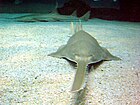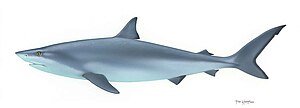Batomorphi
| Batoidea Temporal range:
| |
|---|---|

| |
| Devil fish, Mobula mobular | |
| Scientific classification | |
| Kingdom: | |
| Phylum: | |
| Class: | |
| Subclass: | |
| Superorder: | Batoidea
|
| Orders | |

Batoidea is a superorder of cartilaginous fish commonly known as batoids or rays, but it also includes the skates and sawfishes. Approximately 560 species are described in thirteen families. Batoids are in the fish subclass Elasmobranchii along with sharks, as they are closely related. Rays are distinguished by their flattened bodies, enlarged pectoral fins that are fused to the head, and gill slits that are placed on their ventral surfaces.
Anatomy
Batoids are flat-bodied, and, like sharks, are cartilaginous marine fish, meaning they have a boneless skeleton made of a tough, elastic substance. Most batoids have five ventral slot-like body openings called gill slits that lead from the gills, but the Hexatrygonidae have six.[2] Batoid gill slits lie under the pectoral fins on the underside, whereas a shark's are on the sides of the head. Most batoids have a flat, disk-like body, with the exception of the guitarfishes and sawfishes, while most sharks have a streamlined body. Many species of batoid have developed their pectoral fins into broad flat wing-like appendages. The anal fin is absent. The eyes and spiracles are located on top of the head. Batoids have a ventrally located mouth and can considerably protrude their upper jaw (palatoquadrate cartilage) away from the cranium to capture prey.[3] The jaws have euhyostylic type suspension, which relies completely on the hyomandibular cartilages for support.[4] Bottom-dwelling batoids breathe by taking water in through the spiracles, rather than through the mouth as most fishes do, and passing it outward through the gills.
Reproduction
Batoids reproduce in a number of ways. As is characteristic of elasmobranchs, batoids undergo internal fertilisation. Internal fertilisation is advantageous to batoids as it conserves sperm, does not expose eggs to consumption by predators, and ensures that all the energy involved in reproduction is retained and not lost to the environment.[5] All skates and some rays are oviparous (egg laying) while other rays are ovoviviparous, meaning that they give birth to young which develop in a womb but without involvement of a placenta.
The eggs of oviparous skates are laid in leathery egg cases that are commonly known as mermaid's purses and which often wash up empty on beaches in areas where skates are common.
Habitat
Most species live on the sea floor, in a variety of geographical regions — mainly in coastal waters, although some live in deep waters to at least 3,000 metres (9,800 ft). Most batoids have a cosmopolitan distribution, preferring tropical and subtropical marine environments, although there are temperate and cold-water species. Only a few species, like manta rays, live in the open sea, and only a few live in freshwater, while some batoids can live in brackish bays and estuaries.
Feeding
Most batoids have developed heavy, rounded teeth for crushing the shells of bottom-dwelling species such as snails, clams, oysters, crustaceans, and some fish, depending on the species. Manta rays feed on plankton.
Classification
| |||||||||||||||||||||||||||
| Phylogenetic tree of Batoidea[6][page needed] |
The classification of batoids is currently undergoing revision; however, molecular evidence refutes the hypothesis that skates and rays are derived sharks.[7] Nelson's 2006 Fishes of the World recognizes four orders. The Mesozoic Sclerorhynchoidea are basal or incertae sedis; they show features of the Rajiformes but have snouts resembling those of sawfishes.
| Order | Image | Common name | Family | Genera | Species | Comment | notes | |||
|---|---|---|---|---|---|---|---|---|---|---|
| Total | ||||||||||
| Myliobatiformes | 
|
Stingrays and related species | 10 | 29 | 223 | 1 | 16 | 33 | Myliobatiformes include stingrays, butterfly rays, eagle rays, and manta rays. They were formerly included in the order Rajiformes, but more-recent phylogenetic studies have shown that they are a monophyletic group, and that its more-derived members evolved their highly flattened shapes independently of the skates.[8] | |
| Rajiformes | 
|
Skates and related species | 5 | 36 | 270 | 4 | 12 | 26 | Rajiformes include skates, guitarfishes, and wedgefishes. They are distinguished by the presence of greatly enlarged pectoral fins, which reach as far forward as the sides of the head, with a generally flattened body. The undulatory pectoral fin motion diagnostic to this taxon is known as rajiform locomotion. The eyes and spiracles are located on the upper surface of the body, and the gill slits on the underside. They have flattened, crushing teeth, and are generally carnivorous. Most species give birth to live young, although some lay eggs inside a protective capsule or mermaid's purse. | |
| Torpediniformes | 
|
Electric rays | 4 | 12 | 69 | 2 | 9 | The electric rays have electric organs in their pectoral fin discs that generate electric current. They are used to immobilize prey and for defense. The current is strong enough to stun humans, and the ancient Greeks and Romans used these fish to treat ailments such as headaches.[9] | ||
| Pristiformes | 
|
Sawfish | 1 | 2 | 5-7 | 3-5 | 2 |
The sawfishes are shark-like in form, having tails used for swimming and smaller pectoral fins than most batoids. The pectoral fins are attached above the gills as in all batoids, giving the fishes a broad-headed appearance. They have long, flat snouts with a row of tooth-like projections on either side. The snouts are up to 1.8 metres (6 ft) long, and 30 centimetres (1 ft) wide, and are used for slashing and impaling small fishes and to probe in the mud for embedded animals. Sawfishes can enter freshwater rivers and lakes. Some species reach a total length of 6 metres (20 ft). |
||
Order Torpediniformes
- Family Narcinidae (numbfishes)
- Family Torpedinidae (torpedo electric rays)
Order Pristiformes
- Family Pristidae (sawfishes)
Order Rajiformes
- Family Anacanthobatidae (smooth skates)
- Family Rajidae (skates)
- Family Rhinidae (bowmouth guitarfishes)
- Family Rhinobatidae (guitarfishes)
- Family Rhynchobatidae (wedgefishes)
Order Myliobatiformes
- Family Dasyatidae (whiptail stingrays)
- Family Gymnuridae (butterfly rays)
- Family Hexatrygonidae (sixgill stingrays)
- Family Myliobatidae (eagle rays)
- Family Platyrhinidae (thornbacks)
- Family Plesiobatidae (deepwater stingrays)
- Family Potamotrygonidae (river stingrays)
- Family Urolophidae (round stingrays)
- Family Urotrygonidae (American round stingrays)
- Family Zanobatidae (panrays)
Difference between sharks and rays
Sharks and rays are both cartilaginous fishes which can be contrasted with bony fishes. Rays are basically flattened sharks, adapted for feeding on the bottom. Guitarfish are somewhat between sharks and rays show characteristics of both (though they are classified as rays).
| Comparison of sharks, guitar fishes and rays | ||||
|---|---|---|---|---|
| Characteristic | Shark | Guitar fish | Ray | Sources |
| Shape | laterally compressed spindle | dorsoventrally compressed (flattened) disc | dorsoventrally compressed (flattened) disc | |
| Spiracles | not always present | always present | ||
| Habitat | usually pelagic surface feeders, though carpet sharks are demersal bottom feeders | demersal/pelagic mix | usually demersal bottom feeders | |
| Eyes | usually at the side of the head | usually on top of the head | usually on top of the head | |
| Gill openings | on the sides | ventral (underneath) | ||
| Pectoral fins | distinct | not distinct | not distinct | |
| Tail | large caudal fin used for propulsion | caudal fin that can be used for propulsion | varies from thick tail as extension of body to a whip that can sting to almost no tail. | |
| Locomotion | swim by moving their caudal (tail) fin from side to side | Guitar fish and sawfish have a caudal fin like the shark. | swim by flapping their pectoral fins like wings. | |

|

|

|
||
References
Notes
- ^ Stevens, J. & Last, P.R. (1998), Paxton, J.R. & Eschmeyer, W.N. (ed.), Encyclopedia of Fishes, San Diego: Academic Press, p. 60, ISBN 0-12-547665-5
{{citation}}: CS1 maint: multiple names: authors list (link) - ^ Martin 2010.
- ^ Motta, PJ; Wilga, CD (2001), "Advances in the study of feeding behaviors, mechanisms, and mechanics of sharks", Environmental Biology of Fishes, 60: 131–56, doi:10.1023/A:1007649900712.
- ^ Wilga, CAD (2008), "Evolutionary divergence in the feeding mechanism of fishes", Acta Geologica Polonica, 58: 113–20.
- ^ "Reproduction overall". Skates and rays of Atlantic Canada. Canadian Shark Research Lab, Bedford Institute of Oceanography & Marine Fish Species, Risk Section, Northwest Atlantic Fisheries Center. Retrieved 27 May 2012.
- ^ McEachran & Aschliman 2004.
- ^ Douady, CJ; Dosay, M; Shivji, MS; Stanhope, MJ (2003), "Molecular phylogenetic evidence refuting the hypothesis of Batoidea (rays and skates) as derived sharks", Molecular Phylogenetics and Evolution, 26 (2): 215–21, doi:10.1016/S1055-7903(02)00333-0, PMID 12565032.
- ^ Nelson, J.S. (2006), Fishes of the World (fourth ed.), John Wiley, pp. 69–82, ISBN 0-471-25031-7
- ^ Bullock, Theodore Holmes; Hopkins, Carl D; Popper, Arthur N; Fay, Richard R (2005), Electroreception, Springer, pp. 5–7, ISBN 0-387-23192-7
- ^ Faria VV, McDavitt MT, Charvet P, Wiley TR, Simpfendorfer CA and Naylor GJP (2013) "Species delineation and global population structure of Critically Endangered sawfishes (Pristidae)" Zoological Journal of the Linnean Society, 167 (1): 136–164. doi:10.1111/j.1096-3642.2012.00872.x
Bibliography
- Shark references. Database of bibliography of living/fossil sharks and rays (Chondrichtyes: Selachii) with more than 15.000 listed papers and many download links.
- Martin, R Aidan (February 2010), "Batoids: Sawfishes, Guitarfishes, Electric Rays, Skates, and Sting Rays", Elasmo research, ReefQuest Centre for Shark Research.
- McEachran, JD; Dunn, KA; Miyake, T (1996), "Interrelationships of the batoid fishes (Chondrichthyes: Batoidea)", Interrelationships of Fishes, Academic Press.
- McEachran, JD; Aschliman, N (2004), "Phylogeny of batoidea", in Carrier, JC; Musick, JA; Heithaus, MR (eds.), Biology of sharks and their relatives, Boca Raton: CRC Press, pp. 79–114.
- Nelson, Joseph S (2006) Fishes of the World Edition 4, illustrated. John Wiley & Sons. ISBN 9780471756446. PDF
See also
External links

